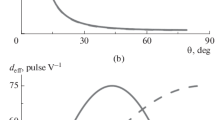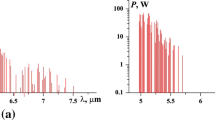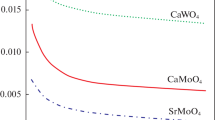Abstract
The CO2 laser radiation at 10.5910–9.2714 μm was up-converted to the visible in the 90° phase-matched AgGa0.86In0.14S2 crystal by mixing with the output of the 0.3547 μm pumped BBO optical parametric oscillator at 25–120 °C. The new Sellmeier and thermo-optic dispersion formulas that reproduce these experimental results correctly as well as the previously published data [Banerjee et al. in Appl Phys B 87:101, (2007); Opt Commun 227:202 (2007)] for difference-frequency generation at 4.05–6.98 μm and second-harmonic generation at 5.2955 μm are presented.
Similar content being viewed by others
Avoid common mistakes on your manuscript.
1 Introduction
In previous publications [1, 2], we have reported the Sellmeier and thermo-optic dispersion formulas for AgGa0.86In0.14S2 that provide a good reproduction for difference-frequency generation (DFG) at 4.05–6.98 μm and second-harmonic generation (SHG) at 5.2955 μm. However, a somewhat large discrepancy between theory and experiment was encountered for the 90° phase-matched up-conversion of the CO2 laser radiation achieved in this crystal. For instance, the experimentally observed OPO pump wavelengths for up-conversion of the 10.5910–9.2714 μm radiation are 14–17 nm shorter than the values given by the above-mentioned Sellmeier equations. In addition, a significant difference between theory and experiment was found for the temperature-dependent phase-matching conditions for this process. Thus, we have corrected these formulas so as to satisfy the new experimental results, and simultaneously fit the data points presented in [1, 2].
Here, we report the new experimental results on the 90° phase-matched up-conversion of the CO2 laser radiation in AgGa0.86In0.14S2 and the new Sellmeier and thermo-optic dispersion formulas for this crystal.
2 Experiments and discussions
The experiments were carried out with a step-tunable CW CO2 laser and a 0.3547 μm pumped BBO optical parametric oscillator (OPO) as the pump source. Both beams were combined with a ZnSe optical flat and collinearly incident on the refabricated, 7-mm-long, θ = 90° cut AgGa0.84In0.16S2 crystal mounted on the temperature controlled oven.
The OPO pump power was adjusted to 5–10 mJ at 10 Hz to avoid the surface damage of the AgGa0.84In0.16S2 crystal, and the CO2 laser power was adjusted to less than 20 mW to avoid local heating. The unfocused beam diameter was 4 mm for the former and 2 mm for the latter.
The pump and output wavelengths were measured by a 0.5-m spectrometer with an accuracy of less than 0.1 nm.
By fixing the CO2 laser wavelengths at 9.2714–10.5910 μm, and by tuning the BBO/OPO wavelength from 0.65 to 0.70 μm, we have measured the 90° phase-matching pump wavelengths at 25 °C. The resulting experimental points (open circles) are shown in Fig. 1 together with the theoretical curves (A) and (B) that were calculated with the Sellmeier equations of Banerjee et al. [1, 2] for this crystal and those of Badikov et al. [3] for AgGa1 − x In x S2(x = 0.008 and 0.20), which differ significantly from the data points. The real line (C) is calculated with the following Sellmeier equations:
90° phase-matching wavelengths for up-conversion of the CO2 laser radiation in AgGa0.86In0.14S2 at 25 °C. The dashed line (a) and the real line (b) are the theoretical carves calculated with the Sellmeier equations of Banerjee et al. [1, 2] and the present authors given in the text. The dashed line (c) is calculated with the Sellmeier equations of Badikov et al. [3] for AgGa1-xInxS2(x = 0.08 and 0.20). Open circles experimental points. Open triangle calculated points
where λ is in μm, and reproduce correctly the experimental points. This index formula was constructed by using the refractive indices previously measured by Banerjee et al. [1] at 0.6328, 1.0642, 10.5910 μm and those measured by us at 3.3913 μm, and adjusted them to give the best fit to the experimental points.
The measured acceptance angles and spectral phase-matching bandwidths at full-width at half-maximum (FWHM) are Δθint·ℓ½ = (2.3 ± 0.1) deg cm½ and Δλp·ℓ = (0.4 ± 0.1) nm cm, which agree well with the theoretical values of Δθint·ℓ½ = 2.35 deg cm½ and Δλp· ℓ = 0.39 nm cm for the CO2 laser wavelength of 10.5910 μm and Δθint·ℓ½ = 2.34 deg cm½ and Δλp·ℓ = 0.48 nm cm for the CO2 laser wavelength of 9.2714 μm.
Note that the ordinary and extraordinary refractive indices of AgGa1 − x In x S2 increase and the birefringence decrease as a function of In concentrations [3] as in the case of AgGa1 − x In x Se2 [4]. While the Sellmeier equations of Banerjee et al. [1, 2] give the ordinary refractive indices that are smaller than those of pure AgGaS2 [5] at wavelengths longer than 2.42 μm; in contrast, the new Sellmeier equations give the normal dispersion [n(AgGa0.86In0.14S2) > n(AgGaS2)] throughout the whole spectral range. In addition, this index formula correctly reproduces the 90° phase-matched DFG between the Ti:Al2O3 laser at 0.84274 μm and the Nd:YAG laser at 1.0642 μm as well as the phase-matching angle of θPM = 80.8° and 73.0° for SHG of the CO2 laser lines at 10.5910 [1, 2] and 10.2466 μm, respectively.
Next we measured the temperature-dependent phase-matching conditions by heating the crystal from 25 to 120 °C. The resulting tuning points (open circles) for the CO2 laser wavelengths of 10.5910 and 9.5525 μm are shown in Fig. 2.
Temperature-dependent 90° phase-matching wavelengths for up-conversion of the CO2 laser radiation in AgGa0.86In0.14S2. The dashed lines (a) are the theoretical curves calculated with the Sellmeier equations of the present authors coupled with the thermo-optic dispersion formulas of Banerjee et al. [1, 2] and the real lines (b) are the theoretical carves calculated those of the present authors presented in the text. Open circles experimental points
The dashed lines (A) are calculated with our new Sellmeier equations (Eq. 1) combined with the thermo-optic dispersion formula of Banerjee et al. [2], which differ again from the experimental points. The real lines (B) are calculated with our new Sellmeier equations and the thermo-optic dispersion formula given by
where λ is in μm, and reproduce the experimental points correctly. The slope of the BBO/OPO pump wavelength versus crystal temperature is dλp/dT = 0.101 and 0.108 nm/ °C for the CO2 laser wavelength of 10.5910 and 9.5525 μm, respectively. The temperature phase-matching bandwidth (FWHM) for this process is ΔT ℓ = (3.4 ± 0.1) °C cm, which agrees well with the calculated values of ΔT ℓ = 3.3 and 3.5 °C cm for the respective CO2 laser wavelengths of 10.5910 and 9.5525 μm.
In addition, we note that Eqs. (1) and (2) reproduce correctly the phase-matching points for SHG of the CO2 laser line at 10.5910 μm given by Banerjee et al. [1, 2]. at 25–203 °C. However, because our calculated values for DFG based on the Nd:YAG laser do not fit their data points shown in Figs. 3 and 4 of [2] except at 120 °C, we have carefully checked these data points and found a distinct difference between the DFG wavelengths obtained at 25 °C by mixing the Ti:Al2O3 laser the Nd:YAG laser [1] and by mixing the BBO/OPO and Nd:YAG laser [2] in the same crystal. The former is 4.0497 μm as noted in the preceding, while the latter is 4.0258 μm (Fig. 3 of [2]).
Temperature-tuned 90° phase-matched difference-frequency generation between the BBO/OPO and the Nd:YAG laser in AgGa0.86In0.14S2. The dashed line (a) and the real line (b) are the theoretical curves calculated with the Sellmeier and thermo-optic dispersion formulas of Banerjee et al. [1, 2] and those of present authors presented in this text. Open circles our experimental points. Open triangle experimental points taken from [2]
In order to clarify this inconsistency, we have once again measured DFG between the BBO/OPO and the Nd:YAG laser under the identical experimental conditions described in [2]. The resulting tuning points (open circles) are shown in Figs. 3 and 4 together with the data points (triangles) taken from [2]. As can be seen from these figures, our data points agree excellently with the theoretical values calculated with Eqs. (1) and (2). Thus, the data point shown in Fig. 3 of [2] is thought to be in error.
3 Conclusion
In summary, we have reported the 90° phase-matched up-conversion of the CO2 laser radiation at 9.2714–10.5910 μm in AgGa0.86In0.14S2. These data were used to construct the new Sellmeier and thermo-optic dispersion formulas that provide the excellent reproduction of these experimental results as well as the previously published data [1, 2] of DFG at 4.05–6.98 μm and SHG of the CO2 laser at 10.5910 μm. We believe that these Sellmeier and thermo-optic dispersion formulas are highly useful for predicting the temperature-dependent phase-matching conditions for frequency conversion in the AgGa1−x In x S2 (x ≦ 0.14) crystals when combined with our index and thermo-optic dispersion formulas for pure AgGaS2 [5].
References
S. Banerjee, K. Miyata, K. Kato, N. Saito, S. Wada, Appl. Phys. B 87, 101 (2007)
S. Banerjee, K. Miyata, K. Kato, Opt. Commun. 227, 202 (2007)
V.V. Badikov, I.N. Matveev, V.L. Panyutin, S.M. Pshenichnikov, A.E. Rozenson, S.V. Skrebneva, N.K. Trotsenko, N.D. Ustinov, Sov. J. Quantum Electron 10(10), 1302 (1980)
E. Takaoka, K. Kato, Opt. Lett. 24, 902 (1999)
E. Takaoka, K. Kato, Appl. Opt. 38, 4577 (1999)
Open Access
This article is distributed under the terms of the Creative Commons Attribution License which permits any use, distribution, and reproduction in any medium, provided the original author(s) and the source are credited.
Author information
Authors and Affiliations
Corresponding author
Rights and permissions
Open Access This article is distributed under the terms of the Creative Commons Attribution 2.0 International License (https://creativecommons.org/licenses/by/2.0), which permits unrestricted use, distribution, and reproduction in any medium, provided the original work is properly cited.
About this article
Cite this article
Tanno, F., Kato, K. 90° phase-matched up-conversion of CO2 laser radiation in AgGa0.86In0.14S2 . Appl. Phys. B 109, 367–369 (2012). https://doi.org/10.1007/s00340-012-5210-7
Received:
Published:
Issue Date:
DOI: https://doi.org/10.1007/s00340-012-5210-7








